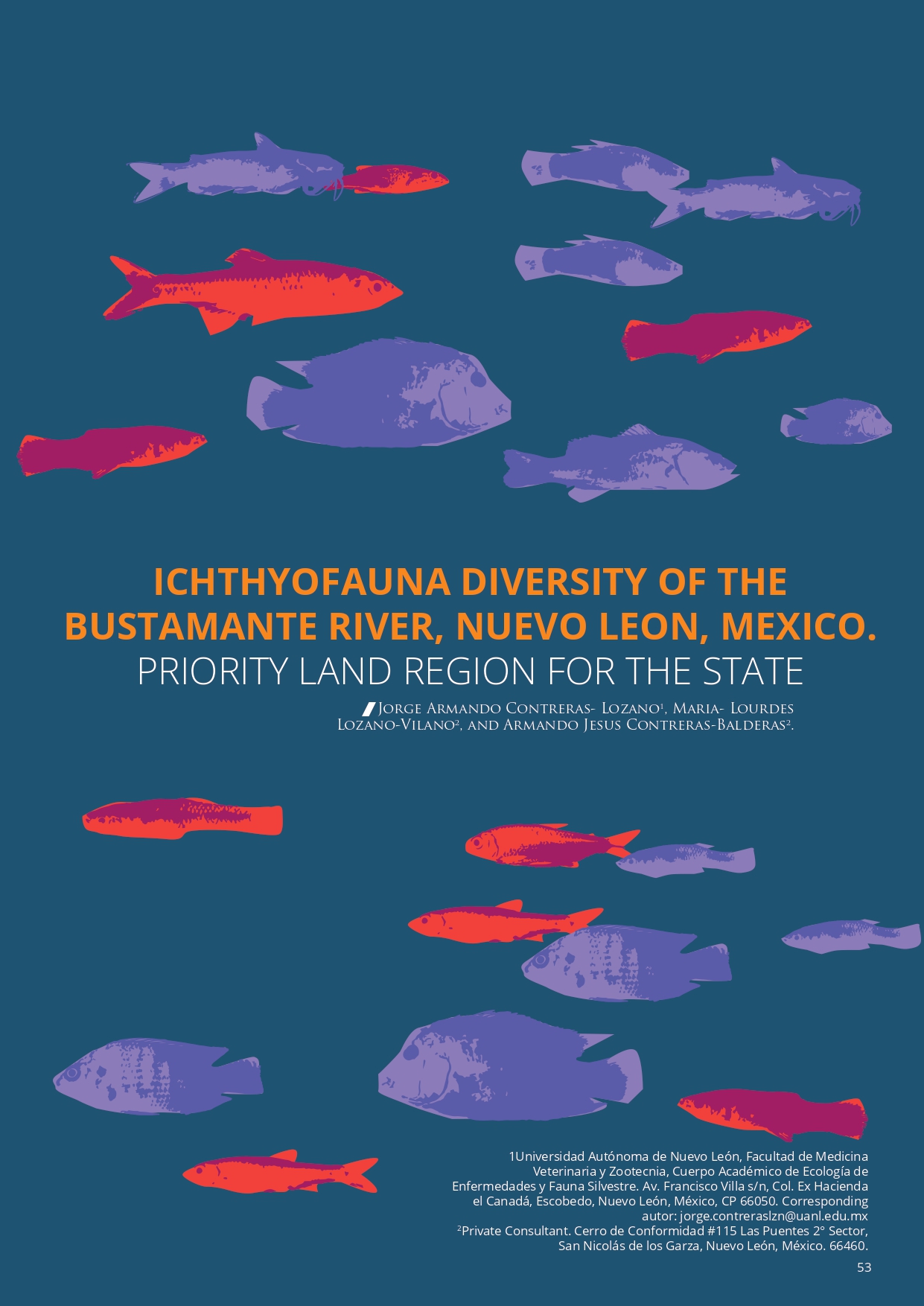Ichthyofauna diversity of the Bustamante River, Nuevo Leon, Mexico
Priority Land Region for the State
DOI:
https://doi.org/10.29105/bys7.14-130Keywords:
Bustamenta, Nuevo León, Rivers, IchthyofaunaAbstract
The state of Nuevo León is in the northern of México, the Bustamante river is in the portion of northwestern of this state. It is a limited area where rainfall and the water are a vital resource for anthropocentric activities. The preservation of the rivers is very important, and the fish communities are override in this region. The study was conducted in a Priority Terrestrial Region, bordering Coahuila. There is the first study on fishes in this river, that the most of time is a close flood, is a tributary of the Salado River, for this reason, the objective was to know the ichthyofauna, as well as conduct a zoogeographical and ecological analysis, and the presence of exotic and/or invasive species. Individuals were collected using seine net and electrofishing equipment, species were identified and stored in the Scientific Collection of FCB-UANL. As a result, were reported the presence of eight native species, where is represented six families and eight genera. There are two species under a status of protection laws of the country, Cyprinella cf. rutilla (Threatened) probably a new species and spotted minnow, Dionda melanops (Endangered). Zoogeographical affinity presents four Nearctic species and four Neotropical species, and three, smallmouth bass, Micropterus dolomieu, Tilapia probably Oreochromis sp. Indet. and Xiphophorus variatus, as exotic species were collected. It is important to continue the surveys due to is possible to find species that important area for conservation.
Downloads
References
Álvarez-del-Villar. 1952. Los peces de Nuevo León y la psicultura rural. Instituto de Investigaciones Científicas, Nuevo León, 43pp.
Álvarez-del-Villar. 1970. Peces mexicanos (claves). Instituto Nacional de Investigación Biológico Pesquera, México, 166pp.
Anonymous. 2000. Áreas naturales para la conservación ecológica en el estado de Nuevo León. Secretaría de Desarrollo Urbano y Obras Públicas y Subsecretaria de Ecología. Gobierno del Estado de Nuevo León, Nuevo León, 341pp.
Arriaga, L., J.M. Espinoza, C. Aguilar, E. Martínez, L. Gómez y E. Loa (coordinadores). 2000. Regiones terrestres prioritarias de México. Comisión Nacional para el Conocimiento y uso de la Biodiversidad, México, 611pp.
Brewer, S.K. y D.J. Orth. 2014. Smallmouth bass Micropterus dolomieu Lacepede, 1802. American Fisheries Society Symposium, 82:9-26. https://www.researchgate.net/publication/281206490_Smallmouth_Bass_Micropterus_dolomieu_Lacepede_1802
Colwell, R. K. 2011. Estimates: Statistical Estimation of Species Richness and Shared Species from Samples. Version 9.1.0, 2018, User's Guide and application publishedat, University of Colorado, Colorado.
Colwell, R.K., y J.A. Coddington. 1994. Estimating terrestrial biodiversity through extrapolation. Philosophical Transactions of the Royal Society of the London Society B. Biological Science. 345(1311): 101-118. https://www.researchgate.net/publication/15227591_Colwell_RK_Coddington_JA_Estimating_terrestrial_biodiversity_through_extrapolation_Philos_Trans_R_Soc_London_B-Biol_Sci_345_101-118. DOI: https://doi.org/10.1098/rstb.1994.0091
Contreras-Balderas, S. 1967. Lista de peces del estado de Nuevo León. Cuadernos del Instituto de Investigación Científica, UANL, 11:1-12.
Contreras-Balderas, S., M.L. Lozano-Vilano, y M.E. García-Ramírez. 1995. Tercer lista anotada y revisada de peces de Nuevo León, México. Pp. 73-78. En: Contreras-Balderas S., F. González-Saldivar, D. Lazcano-Villarreal & A. Contreras-Arquieta (Eds.). Listado preliminar de fauna silvestre del estado de Nuevo León, México. Ediciones Consejo Estatal para la Preservación y Fomento de la Flora y Fauna Silvestre de Nuevo León, Monterrey. 152pp.
Contreras-Balderas, S., M.L. Lozano-Vilano, y M.E. García-Ramírez. 2002. Peces, historia, inventario, y estado de conservación. Pp. 69-74. En: Galán-Wong, L., H.A. Luna-Olvera, J.A. García-Salas, K. Arévalo-Niño, A. Cavazos-Leal & B. Pereyra-Alférez (Eds.). Alba y Horizonte. Universidad Autónoma de Nuevo León, Monterrey, 277pp.
CONANP. 2014. Programa de Manejo Monumento Natural El Cerro de la Silla. SEMARNAT y CONANP, México D.F., 129pp.
Espinosa, H., L. Huidobro, C. Flores, P. Fuentes y R. Funes. 2008. Peces. Pp. 1-78. En: Ocegueda, S. & J. Llorentes-Bousquets (Eds.). Catalogo taxonómico de especies de México, Capital natural de México, Vol. I: conocimiento actual de la biodiversidad. Conabio, México, CD, 78pp.
Fricke, R., W.N. Eschmeyer, y R. Van der Laan. 2024. Eschmeyer's catalog of Fishes: Genera, Species, References. En: http://researcharchive.calacademy.org/research/ichthyology/catalog/fishcatmain.asp (consultado el 07/02/2024).
García-Contreras, E.V. 2012. Ictiofauna de las áreas naturales protegidas Monumento Natural Cerro de la Silla y Sierra de la Silla, Nuevo León, México. Tesis Licenciatura, Facultad de Ciencias Biológicas, Universidad Autónoma de Nuevo León, Monterrey, 72pp.
Darlington, P.J.Jr. 1963. Zoogeography: the geographical distribution of animals. J. Wiley & Sons, New York, London, 675pp.
Lozano-Vilano, M., M. García-Ramírez y M. Espinoza-Narváez. 2013. Peces. Pp. 195-206. En: Cantú-Ayala, C., M. Rovalo-Merino, J. Marmolejo-Moncivais, S. Ortiz-Hernández & F. Seriña-Garza (Eds.). Historia Natural del Parque Nacional Cumbres de Monterrey, México. UANL-CONANP, México, 414pp.
Martínez- Muñoz, A. y M. Rodríguez- González. 2018. Estudio técnico justificativo para la declaratoria de la Sierra de Bustamante como Monumento Natural Estatal, en el municipio de Bustamante Nuevo León. En: http://mundosustentable.org/bienvenidos/wp-content/uploads/2018/07/ETJ-Bustamante-v4jul2018.pdf (consultado el 01/04/2023).
Miller, R.R., W.L. Minckley y S.M. Norris. 2005. Freshwater fishes of México. University of Chicago Press, Chicago, 490pp.
Meek, S.E. 1904. The freshwater fishes of México North of the Isthmus of Tehuantepec. Publication of the Field Columbian Museum, Zoological Series V., Chicago, 252pp. DOI: https://doi.org/10.5962/bhl.title.2229
Moreno, C.E. 2001. Métodos para medir la biodiversidad. M&T- Manuales y Tesis SEA, Zaragoza, 83pp.
Nelson, J.S., E.J. Crossman, H. Espinosa-Pérez, L.T. Findley, C.R. Gilbert, R.N. Lea, y J.D. Williams. 2004. Common and scientific names of fishes from the United States, Canada and México. American Fisheries Society, Special Publication 29, Bethesda, Maryland, USA, 386pp.
Root, T.L., S.H. Schneider, R. Warren, J.R. Price, y P.R. Mastrandrea. 2013. Climate change and wild species. Pp. 79-99. En: S.A. Levin (Ed.). Encyclopedia of Biodiversity. Academic Press, USA, 5504pp. DOI: https://doi.org/10.1016/B978-0-12-384719-5.00394-4
SEMARNAT. 2010. Norma Oficial Mexicana NOM-059-SEMARNAT-2010, Protección ambiental-Especies nativas de México de flora y fauna silvestres-Categorías de riesgo y especificaciones para su inclusión, exclusión o cambio-Lista de especies en riesgo. Secretaria del Medio Ambiente y Recursos Naturales (SEMARNAT), Diario Oficial, México.
Soria- Barreto, M., A.A. González-Díaz, A. Castillo-Domínguez, N. Álvarez-Pliego y R. Rodiles-Hernández. 2018. Diversidad íctica en la cuenca del Usumacinta, México. Revista Mexicana de Biodiversidad, 89(2018): S100-S117. https://doi.org/10.22201/ib.20078706e.2018.4.2462 DOI: https://doi.org/10.22201/ib.20078706e.2018.0.2462
Torres-Jaramillo, J., J.M. Muñoz, H. Cárdenas, L.A. Álvarez, y J.D. Palacio. 2010. Caracterización de tilapia roja (Oreochromis sp.) con marcadores moleculares RAPD. Acta Agronómica, 59(2): 236-246. https://www.redalyc.org/articulo.oa?id=169916224012







